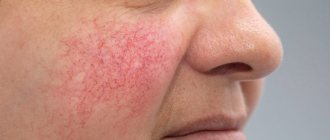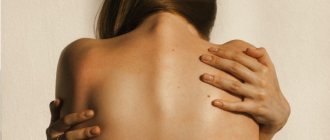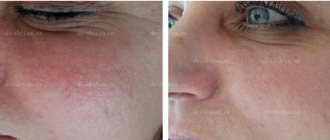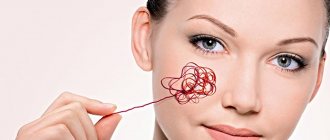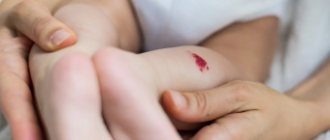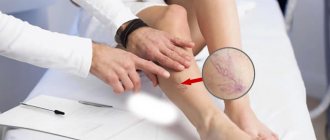There are no nerve endings in the liver tissue, so even in the “near-death” state it does not hurt. With cirrhosis, heaviness may be felt in the right hypochondrium, but does this symptom suggest thoughts of an incurable disease? However, a diseased liver still shows some signs. They are conventionally divided into large and small. “Large liver signs” are directly related to the liver, while “small” ones can indicate many other problems in the body. Still, the simultaneous appearance of even a few minor symptoms should prompt you to make an appointment with a doctor.
How not to turn your liver into foie gras. Simple and effective measures Foie gras is translated from French as fatty liver. This is what doctors colloquially call non-alcoholic fatty liver disease.
Causes of spider veins
Spider veins, medically called telangiectasias, are dilated capillaries (small blood vessels) with a diameter of up to 1.5 mm, blue or red. They are localized on any part of the body, but are most often found on the legs and face. The cause of their occurrence is stagnant processes in the bloodstream due to hemodynamic disturbances.
The risk group for the development of this pathology includes people who are obese, are exposed to heavy physical activity, are on their feet for a long time due to professional activities and lead a passive lifestyle.
"Small liver signs"
Usually a person does not pay attention to “minor liver signs” for a long time, because they are not significant. Rarely does anyone associate them with the condition of the liver, except gastroenterologists and hepatologists:
- Telangiectasia - spider veins. Among the reasons for their appearance: chronic varicose veins, rosacea, systemic connective tissue diseases, endocrine disorders, and liver pathologies. Stars on the legs are usually a sign of varicose veins, but telangiectasias on other parts of the body - in the area of the wings of the nose, chin, cheeks, buttocks - usually appear due to other problems, including the liver;
- Xanthelasmas are flat, yellowish cholesterol plaques that are visible under the skin. They can appear on any part of the body, but they are most visible in the eyes. They occur both with congenital disorders of lipid metabolism and against the background of acquired diseases: diabetes mellitus, hypothyroidism, pancreatitis, hepatitis and cirrhosis of the liver.
- Palmar or plantar erythema – bright pink palms and/or soles. This symptom is also called liver palms (spots appear much less frequently on the feet). The palms turn red symmetrically, the rash appears in the form of small spots. If you press on the reddened area, it disappears, but after a while it appears again. Palmar erythema in liver disease may be accompanied by increased fatigue, weakness, and a slight increase in body temperature. It can also be a symptom of other problems in the body: excess vitamin A, deficiency of vitamin B, contact dermatitis, tuberculosis, thyroid pathologies, etc.;
- Leukonychia - white spots and stripes on the nails. Many people believe that the main reason for whitening nails is a lack of trace elements (for example, zinc). But in fact, the range of reasons is much wider. Leukonychia can appear against the background of infections, metabolic problems, kidney and liver diseases, anorexia and constant stress;
- Gynecomastia is enlargement of the mammary glands in men. It can develop not only with hormonal disorders, but also with liver cirrhosis;
- Testicular atrophy. This pathology often occurs due to inflammatory and infectious processes, injuries, testosterone replacement therapy and the use of anabolic steroids. But severe liver disease, kidney disease and hemochromatosis also predispose to testicular atrophy;
- Hypertrophy of the parotid glands;
- Capillary network on the face.
If you have more than one of the signs on this list, see your doctor and ask for a liver test (liver enzyme test and ultrasound). Such symptoms do not arise “out of the blue” in any case. It will not hurt to find out what is happening to the body and how to help it.
It's all due to hormones
One of the main factors provoking the development of spider veins is a hormonal imbalance in the body.
Restructuring of the endocrine system occurs in the following conditions:
- pregnancy;
- menopause;
- uterine fibroids;
- ovarian cyst;
- abortion and others.
Pregnant women complain about the appearance of vascular “spiders” in the face, legs and abdomen precisely in the last stages of pregnancy. This is due to increased stress on weakened blood vessels. They stretch under the influence of pressure inside themselves and protrude above the surface of the skin.
Telangiectasia often affects the skin after taking birth control pills or installing a hormonal IUD. That is why the selection of contraceptives should be carried out by a gynecologist based on the results of the examination. If a woman notices scarlet stars on her chest, then this is a reason to contact a mammologist or oncologist. Breast cancer at an early stage can manifest itself with these symptoms.
Diagnostic procedures
The biomaterial is collected in the morning on an empty stomach.
The easiest places to spot skin spots are on the arms and upper torso area. In this case, it is necessary to undergo additional tests and undergo instrumental studies to determine the condition and ability of the liver to function. It is important to do a general and biochemical blood test, as well as determine the content of basic enzymes. Ultrasound examination of the organ will help to identify structural abnormalities of the parenchyma, and angiography or Dopplerography is indicated to diagnose abnormalities in the vascular bed.
Varicose veins and spiders
The formation of spider veins on the legs is often associated with the first signs of a disease such as varicose veins. Patients mistakenly believe that it covers only the large main vessels of the legs, and in medicine they believe that capillaries are also susceptible to the occurrence of the disease.
When the vessels of the lower extremities are affected, tree-like telangiectasias of red or blue color are found, which resemble a mesh. If measures are not taken in time, the disease begins to progress, and other symptoms appear: night cramps in the legs, leg fatigue, pain when walking. To avoid unpleasant consequences, you need to consult a phlebologist who diagnoses and treats diseases of the arteries and veins of the lower extremities.
What is pigmentation?
The defect occurs when toxins accumulate in the liver.
It appears mainly in older people. But when the functioning of the liver is impaired, this symptom appears quite often and is a manifestation of insufficient removal of harmful substances from the body. The spot is a limited area of hyperpigmentation, which over time changes color to a more saturated one and increases in size. These formations can appear on the entire surface of the skin. The formation of pigment is associated with the accumulation of bilirubin in the skin, which remains after the breakdown of red blood cells and must be excreted by the liver. Under the influence of the sun, the severity of age spots increases significantly, and sometimes plaques and bubbles filled with clear liquid form on their surface. Liver spots can be brown, red or brown, depending on the intensity of pigment saturation.
Pigment spots are predominantly located on the arms and upper torso.
Other symptoms
Pigmentation and the liver are associated only if there is a clinical picture characteristic of cirrhosis, which includes the following signs:
- nausea, vomiting;
- weight loss;
- loss of appetite;
- yellowness of the mucous membrane, skin and sclera;
- painting the palms red;
- an increase in the size of the abdomen with the formation of ascites;
- hemorrhagic rash;
- body itching;
- dystrophic changes in the oral cavity;
- pain in the right hypochondrium;
- disruption of the digestive process.
Spider veins in obesity
It is no secret that the body of obese people daily experiences a load tens of times higher than normal. Stretched and flabby vessels, which are not able to perform their job efficiently, are called upon to supply a rather large body with blood. This is why spider veins are common in people who are overweight. And the greater this excess, the greater the likelihood of this pathology occurring. Low physical activity in such a situation only contributes to the aggravation of the process: stagnation in the bloodstream begins to form, contributing to the development of thrombophlebitis.
What functions of the liver take care of the skin?
The work of the liver can be compared to a non-stop factory for the synthesis of vital materials, the neutralization of toxic substances that have entered the body, participation in digestion, and the production of energy for existence. All together is called internal metabolism or metabolism.
As a result of complex biochemical processes, the body maintains the required level of immunity, the concentration of vitamins, and some hormones (sex, adrenal, thyroid). Ensures growth and adaptation to various life situations.
The skin also participates in protection and elimination of toxins through sweat. But for their functioning, skin cells must receive energy from the liver, building material (proteins), collagen to ensure elasticity and turgor, vitamins A, E, C to remove hydroxyl residues and fight aging.
A depot of water- and fat-soluble vitamins B, PP, D, K, and microelements (copper, iron, cobalt) is created in the liver. In the absence of them in food, thanks to these reserves, the body can painlessly support itself for some time.
Vascular “spiders” are formed by blocking the blood outlet from the capillaries
Nutrients and oxygen flow through the vessels. Their patency is maintained with the help of the blood coagulation and anticoagulation systems, which receive components from the liver. And the structure of the walls depends on the ratio of lipoprotein fractions, cholesterol and triglyceride content. Pastiness, swelling of the skin, hemorrhagic rashes, and bruises indicate a violation of this process.
It is important to remember that toxic substances are not only alcohol, drugs, or obviously poor-quality and poisonous products. They are constantly formed during metabolism during the breakdown of proteins, phenolic compounds, and acetone. It is only thanks to good detoxification in the liver that we do not feel them.
The production of antibodies, immunoglobulins and other components of the immune system makes it possible to protect the skin from infection by external agents and limit the infection by a local inflammatory reaction.
Neutralization of bilirubin by binding it with glucuronic acid creates a healthy color of the skin and mucous membranes. Impaired functioning of liver cells is accompanied by external disorders. Therefore, based on the condition of the skin, nails and hair, the doctor may suspect functional failure or liver pathology.
Other causes of spider veins
Pathological changes in the form of spider veins may be a harbinger of systemic connective tissue damage. Doctors call this disease scleroderma, and it is characterized by abnormal thickening of the skin, leading to poor circulation. The pressure created for the passage of blood through compressed capillaries stretches their walls, forming a kind of vascular “spiders”.
A similar process of formation of telangiectasia is characteristic of diseases associated with the liver and gall bladder. In case of cirrhosis or liver cancer, they appear on the skin of the anterior abdominal wall (“head of the jellyfish”) and indicate sclerosis of the liver structures.
Spider veins can also be caused by other factors:
- cardiovascular diseases;
- decreased vascular tone due to lack of vitamins C and P;
- constant exposure to heat on the body;
- blood clotting disorder;
- hereditary predisposition;
- exposure to UV and radiation on the body.
Significantly increased blood pressure, at which small vessels can simply burst from stress, can also contribute to the formation of single telangiectasias.
"Large liver signs"
Hepatomegaly is the most common, sometimes the only “big sign” of liver dysfunction. This is a syndrome characterized by an increase in the size of the organ: when the liver is more than 12 cm along the right midclavicular line or its left lobe is palpable in the epigastric region.
Hepatomegaly accompanies a variety of liver diseases: damage to the portal and hepatic veins due to thrombosis, Budd-Chiari syndrome, viral hepatitis, infectious mononucleosis, amoebic abscess, purulent thrombophlebitis of the portal vein, nonspecific cholangitis. Liver enlargement is detected when exposed to toxic substances (alcohol, drugs, etc.), with steatohepatitis, amyloidosis, oncopathology, with diseases of the endocrine system (diabetes mellitus) and liver injuries.
“Major liver signs” also include jaundice and itchy skin. The sclera of the eyes, the frenulum of the tongue and the soft palate are the first to acquire a yellow tint. Next the skin is painted. This occurs when the level of bilirubin in the blood exceeds 45-50 µmol/l. We wrote in detail about how and why jaundice and itchy skin appear here.
There is also the concept of pseudojaundice. It may occur due to consumption of foods rich in beta-carotene or certain medications. In this case, the sclera remains white, the urine remains light, and tests do not show an increase in bilirubin.
Jaundice is most often observed in acute hepatitis (viral, toxic) and at a late stage of liver damage - with cirrhosis. In chronic hepatitis, jaundice is observed quite rarely, only in cases of severe exacerbation.
Gilbert's syndrome: to treat or not to treat? Gilbert's syndrome is a hereditary liver disease that occurs due to impaired bilirubin metabolism.
Prevention of spider veins
If telangiectasias appear on the body without a clinical reason, then recurrence of the cosmetic defect can be prevented by the usual intake of a vitamin complex. It should include substances that help restore tone and strengthen the vessel wall.
To prevent asterisks from arising as a result of any disease, you need to take preventive measures. First of all, give up bad habits, follow the principles of a healthy diet and lead an active lifestyle.
Find out the cost
Features of treatment
Therapy, if the patient has liver pigmentation, can be aimed at eliminating the cause that provoked its appearance. For this purpose, the functioning of the liver and all organs and systems is normalized. If this method does not give a positive result, then laser removal of areas of pigment accumulation or spider veins is indicated. Alternative medicine can be used as a complement to basic methods.
Treatment of the cause
The first stage of treatment is aimed at eliminating the cause of the skin defect.
Liver spots can be removed only after the functioning of all organs and systems has been normalized and the elimination of bilirubin breakdown products from the body has been enhanced. For this purpose, it is recommended to use hepatoprotectors “Essentiale” or “Phosphoglin”, which help restore hepatocytes and normalize blood flow in the liver. Also shown are agents that enhance the removal of toxins “Sirepar” and “Hepatosan”. The amino acids “Heptor” or “Heptral” will be useful.
Herbal products “Gepabena”, “Karsil” and “Hofitol” are also used. It is possible to treat gallstones using bile acid preparations, such as Ursofalk, Ursosan, Exhol and others. Patients must be prescribed a gentle diet, limiting the consumption of fatty, fried and spicy foods. It is important to get rid of bad habits - smoking and alcohol addiction, and also to avoid stress that puts stress on the liver.
Traditional methods
In combination with drug and surgical treatment, non-traditional methods can be used. They help to significantly improve the patient’s condition and reduce the severity of pigmentation. One such method is rubbing aloe, calendula and orange juice into the pigment. This should be done 3 times a day for 2 weeks. Once a week you can apply a mask of cottage cheese, ammonia, lemon juice and white clay. Ice cubes containing frozen decoction of mint, chamomile and aloe pulp will also be useful. They need to be rubbed into your face in the morning.
Laser treatment
The advantage of the procedure is quick results.
If it is not possible to eliminate liver stars, plaques or spots using medication, then surgical removal of these tissues is used. For this purpose, a laser is most often used. It causes minimal damage to the skin and leaves no scarring or wounds. This procedure is painful and is performed under local anesthesia. The effect is noticeable after several courses of laser removal of formations. At the same time, the problem in the liver remains and formations can develop again if their immediate cause is not eliminated.
What skin diseases are caused by liver damage?
Impaired liver cell function reduces the production of protective antibodies and immunoglobulins. Under such conditions, the skin is not able to “repel the attack” of infectious agents. Dryness creates comfortable conditions for penetration into the deeper layers.
Therefore, a rash in liver diseases is a consequence of negative external and internal influences to which the organ is not able to respond.
Acne is most often located on the temples, bridge of the nose, and forehead. Small pustules - boils are always located in the hair follicle area and spread inward. Localized on the arms, legs, chest. They can merge to a significant size with a purulent center, an edematous shaft, and pain.
Allergic manifestations - dermatitis with red spots, plaques, small rashes in the form of urticaria, accompanied by severe itching and fever. Psoriasis - the etiology of the disease has not been fully established, but there is a version that it is provoked by bile acids entering the bloodstream.
It appears as merging pink spots covered with gray thin scales. The disease seriously aggravates liver pathology and affects the joints of the limbs and spine.
Eczema - most often looks like bright, weeping spots located symmetrically on the body, covered with crusts and peeling. Patients with liver disease are prone to fungal infections (mycoses). They develop in the superficial layers, affecting nails and hair, mucous membranes, and skin folds.
How does the appearance of a person with liver pathology change?
An attentive doctor always evaluates the patient's unhealthy appearance in search of symptoms of various diseases. Women's attempts to hide spots on their faces with the help of cosmetics calm patients for a short time, but do not eliminate other skin manifestations.
A sign of a diseased liver in males and females is considered to be a tired appearance, dry, thin skin with a grayish tint. Vessels and an expanded venous network are visible through the surface layers. There are places with peeling, especially on the elbows and knees. The hair is thin, falling out, and there are traces of dandruff on the clothes.
Symptoms of biliary cirrhosis of the liver
A person with liver disease looks older than his biological age. This is confirmed by deep wrinkles, cholesterol deposition on the eyelids (xanthelasmas), a violation of pigment metabolism with the appearance of brown spots on the hands, face, and other parts of the body.
In addition, patients experience increased sweating with a strong, unpleasant odor. On the legs, swelling is located in the ankles and shins. It can be detected by pressing your finger on the skin.
What liver diseases cause changes in the skin?
Liver diseases vary in cause. All of them lead first to the functional inferiority of hepatocytes, then they destroy the organ and replace it with scar tissue.
- Inflammatory pathologies include: viral and toxic hepatitis, damage from tuberculosis and syphilis, abscesses, autoimmune diseases.
- Metabolic disorders are characterized by: alcoholic and non-alcoholic steatohepatosis (fatty degeneration), alcoholic liver disease.
- Consequences of blunt trauma in the abdomen, ruptures, stab wounds, crushing from gunshot wounds.
- Diseases of large vessels: hepatic vein thrombosis, pylephlebitis (portal vein suppuration), portal hypertension in cirrhosis, fistulas and arteriovenous fistulas.
- Pathology of the bile ducts: intrahepatic congestion, acute and chronic purulent cholangitis, formation of stones from salts, congenital dilation of the ducts inside the liver with increased stone formation and small abscesses in the parenchyma.
- Tumor processes: cyst, hemangioma, hepatocellular and intraductal cancer, sarcoma, metastases.
- Parasitic diseases with localization of the focus in the liver are caused by: alveococcus, echinococcus, roundworms, opisthorchiasis, leptospirosis.
- Hereditary anomalies: complete absence or underdevelopment of the organ, narrowing of the ducts, fermentopathy with disruption of various types of metabolism.
In addition, differential diagnosis always takes into account the possibility of secondary liver damage caused by changes in other organs. Therefore, signs of congestion in heart failure, amyloidosis, blood diseases, renal and hepatic failure in diseases of the urinary organs are excluded.
Why does itching occur?
Skin itching due to liver pathology worries the patient more than pain. It exhausts you and doesn't let you sleep. A man combs different parts of his body. Scratches appear on the skin, which quickly become infected and fester. Itching is not relieved by antihistamines and increases significantly with the appearance of jaundice.
Itching of the skin is one of the clearest symptoms of liver pathology.
The causes of itching are the combined effects of:
- stagnation of bile, blockage of ducts;
- increased concentration of bile acids in the blood;
- toxic and poisonous substances that are not neutralized by the liver.

